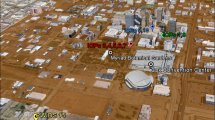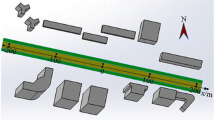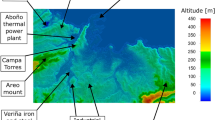Abstract
In order to estimate the impacts of buildings on air pollution dispersion, numerical simulations are performed over an idealized urban area, modelled as regular rows of large rectangular obstacles. The simulations are evaluated with the results of the Mock Urban Setting Test (MUST), which is a near full-scale experiment conducted in Utah’s West Desert area: it consists of releases of a neutral gas in a field of regularly spaced shipping containers. The numerical simulations are performed with the model Mercure_Saturne, which is a three-dimensional computational fluid dynamics code adapted to atmospheric flow and dispersion simulations. It resolves complex geometries and uses, in this study, a k–∈ closure for the turbulence model. Sensitivity studies focus on how to prescribe the inflow conditions for turbulent kinetic energy. Furthermore, different sets of coefficients available in the literature for the k–∈ closure model are tested. Twenty MUST trials with different meteorological conditions are simulated and detailed analyses are performed for both the dynamical variables and average concentration. Our results show overall good agreement according to statistical comparison parameters, with a fraction of predictions for average concentration within a factor of two of observations of 67.1%. The set of simulations offers several inflow wind directions and allows us to emphasize the impact of elongated buildings, which create a deflection of the plume centerline relative to the upstream wind direction.
Similar content being viewed by others
References
Archambeau F, Mechitoua N, Sakiz M (2004) Code_Saturne : a finite volume code for the computation of turbulent incompressible flows - industrial applications. Int J Finite Volumes 1:1–62
Allwine KJ, Shinn JH, Streit GE, Clawson KL, Brown M (2002) Overview of urban 2000 - a multiscale field study of dispersion through an urban environment. Bull Amer Meteorol Soc 83:521–536
Allwine KJ, Leach MJ, Stockham LW, Shinn JS, Hosker RP, Bowers JF, Pace JC (2004) Overview of joint urban 2003 - an atmospheric dispersion study in Oklahoma City. Symposium on Planning, Nowcasting and Forecasting in the Urban Zone, American Meteorological Society, Seattle, Washington, January 11–15
Baik J-J, Kim J-J, Fernando HJS (2003) A CFD model for simulating urban flow and dispersion. J Appl Meteorol 42:1636–1648
Biltoft CA (2001) Customer report for Mock Urban Setting Test. DPG Document No. WDTC-FR-01-121, West Desert Test Center, U.S. Army Dugway Proving Ground, Dugway, Utah, 58 pp
Brook DR, Beck NV, Clem CM, Strickland DC, Griffits IH, Hall DJ, Kingdon RD, Hargrave JM (2002) Validation of the Urban Dispersion Model (UDM). 8th Int. Conf. on Harmonisation within Atmospheric Dispersion Modelling for Regulatory Purposes, Sofia, Bulgaria, October 14–17
Buty D, Caneill JY, Carissimo B (1988) Simulation numerique de la couche limite atmospherique en terrain complexe au moyen d’un modele mesometeorologique non hydrostatique: le code MERCURE. J Theor Appl Mech 7:35–62
Byrne CEI, Holdo AE (1998) Effects of increased geometric complexity on the comparison between computational and experimental simulations. J Wind Eng Indust Aerodyna 73:159–179
Camelli FE, Lohner R, Hanna SR (2005) VLES study of MUST experiment. 43rd AIAA Aerospace Sciences Meeting and Exhibit, Reno, Nevada, January 10–13
Carissimo B, Macdonald RW (2002) A porosity/drag approach for the modeling of flow and dispersion in the urban canopy. In: Borrego C, Schayes G (eds) Air Pollution Modeling and its Application XV. Kluwer Academic Publishers, Dordrecht, pp. 385–391
Chan AT, So ESP, Samad SC (2001) Strategic guidelines for street canyon geometry to achieve sustainable street air quality. Atmos Environ 35:5681–5691
Chang JC, Hanna SR (2004) Air quality model performance evaluation. Meteorol Atmos Phys 87:167–196
Coceal O, Belcher SE (2004) A canopy model of mean winds through urban areas. Quart J Roy Meteorol Soc 130:1349–1372
Duynkerke PG (1988) Application of the E–ε turbulence closure model to the neutral and stable atmospheric boundary layer. J Atmos Sci 45:865–880
Garratt JR (1992) The atmospheric boundary layer. Cambridge Atmospheric and Space Science Series. Cambridge University Press, 316 pp
Grimmond CSB, Oke TR (1999) Aerodynamic properties of urban areas derived from analysis of surface form. J Appl Meteorol 38:1262–1292
Gryning S-E, Lyck E (1984) Atmospheric dispersion from elevated sources in an urban area: comparison between tracer experiments and model calculations. J Clim Appl Meteorol 23:651–660
Hanna SR, Chang JC (2001) Use of the Kit Fox field data to analyze dense gas modeling issues. Atmos Environ 35:2231–2242
Hanna SR, Tehranian S, Carissimo B, Macdonald RW, Lohner R (2002) Comparisons of model simulations with observations of mean flow and turbulence within simple obstacle arrays. Atmos Environ 36:5067–5079
Hanna SR, Hansen OR, Dharmavaram S (2004) FLACS CFD air quality model performance evaluation with Kit Fox, MUST, Prairie Grass, and EMU observations. Atmos Environ 38:4675–4687
Harris VG, Graham JAH, Corrsin S (1977) Further experiments in nearly homogeneous turbulent shear flow. J Fluid Mech 81:657–687
Kastner-Klein P, Plate EJ (1999) Wind-tunnel study of concentration fields in street canyons. Atmos Environ 33:3973–3979
Kastner-Klein P, Berkowicz R, Britter R (2004) The influence of street architecture on flows and dispersion in street canyons. Meteorol Atmos Phys 87:121–131
Kim J-J, Baik J-J (2004) A numerical study of the effects of ambient wind direction on flow and dispersion in urban street canyons using the RNG k-ε turbulence model. Atmos Environ 38:3039–3048
Launder BE, Spalding DB (1974) The numerical computation of turbulent flows. Comp Meth Appl Mech Eng 3:269–289
Lien F-S, Yee E (2004) Numerical modelling of the turbulent flow developing within and over a 3-D building array, PartI: a high-resolution Reynolds-averaged Navier–Stokes approach. Boundary-Layer Meteorol 112:427–466
Macdonald RW (2000) Modelling the mean velocity profile in the urban canopy layer. Boundary-Layer Meteorol 97:25–45
Macdonald RW, Ejim CE (2002) Flow and dispersion data from a hydraulic simulation of the MUST array. Tech. Rep. 2002-3, Department of Mechanical Engineering, University of Waterloo
Musson-Genon L (1995) Comparison of different simple turbulence closures with a one-dimensional boundary layer model. Mon Wea Rev 123:163–180
Nelson MA, Brown MJ, Pardyjak ER, Klewicki JC (2004) Area-averaged profiles over the mock urban setting test array. Fifth AMS symposium on the urban environment, Vancouver, British Columbia, August 2004 23–26
Panofsky HA, Dutton JA (1984) Atmospheric turbulence. Wiley & Sons, New York, 397 pp
Reynolds WC (1974) Computation of turbulent flows. AIAA Paper No.74-556, AIAA seventh Fluid and Plasma Dynamics Conf, Palo Alto
Riddle A, Carruthers D, Sharpe A, McHugh C, Stocker J (2004) Comparisons between FLUENT and ADMS for atmospheric dispersion modelling. Atmos Environ 38:1029–1038
Rotach MW, Gryning S-E, Batchvarova E, Christen A, Vogt R (2004) Pollutant dispersion close to an urban surface - the BUBBLE tracer experiment. Meteorol Atmos Phys 87:39–56
Schatzmann M, Leitl B (2002) Validation and application of obstacle-resolving urban dispersion models. Atmos Environ 36:4811–4821
Sini J-F, Anquetin S, Mestayer P (1996) Pollutant dispersion and thermal effects in urban street canyons. Atmos Environ 30:2659–2677
Stull RB (1988) An introduction to boundary layer meteorology. Kluwer Academic Publishers, Dordrecht The Netherlands, 670 pp
Tavoularis S, Corrsin S (1981). Experiments in nearly homogeneous turbulent shear flow with a uniform mean temperature gradient. Part I. J Fluid Mech 104:311–347
Viollet PL (1988) On the numerical modeling of stratified flows. In: Dronkers J, Leussen W (eds) Physical processes in estuaries. Springer-Verlag, pp 257–277
Wyngaard JC, Cote OR (1974) The evolution of a convective planetary boundary layer. A higher-order closure model study. Boundary-Layer Meteorol 7:289–308
Yee E, Biltoft CA (2004) Concentration fluctuation measurements in a plume dispersing through a regular array of obstacles. Boundary-Layer Meteorol 111:363–415
Author information
Authors and Affiliations
Corresponding author
Rights and permissions
About this article
Cite this article
Milliez, M., Carissimo, B. Numerical simulations of pollutant dispersion in an idealized urban area, for different meteorological conditions. Boundary-Layer Meteorol 122, 321–342 (2007). https://doi.org/10.1007/s10546-006-9110-4
Received:
Accepted:
Published:
Issue Date:
DOI: https://doi.org/10.1007/s10546-006-9110-4




